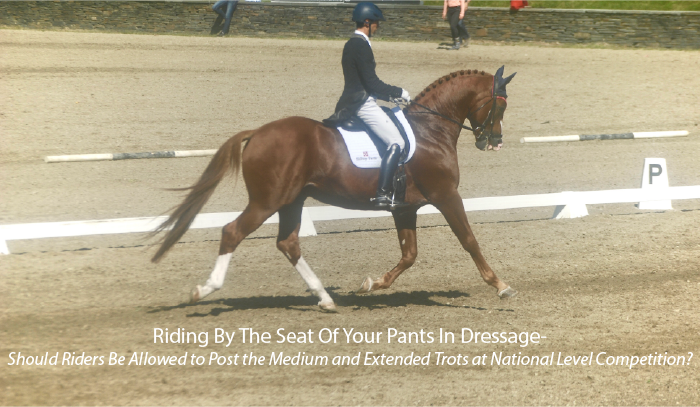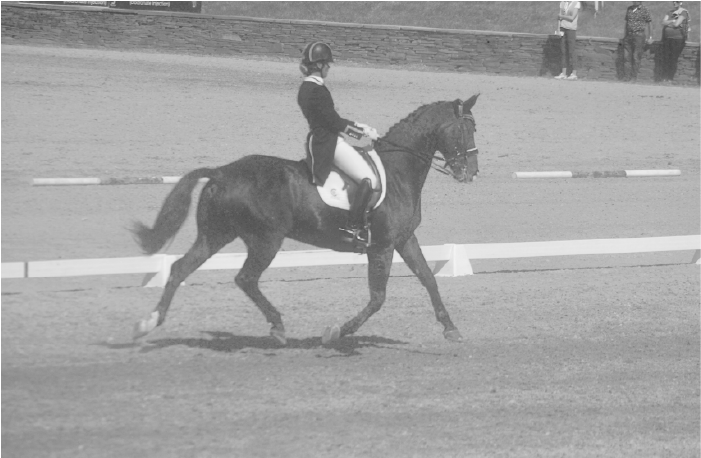Riding By The Seat Of Your Pants In Dressage-
Should Riders Be Allowed to Post the Medium and Extended Trots at National Level Competition?
by Nikki Alvin-Smith

Every rider has to earn their ‘seat’, there is no shortcut to be employed by buying a well-trained, good conformation horse to learn how to use your core and ride without dependence on the reins to maintain the correct position. Although, a soft moving horse that already knows how to collect himself and respond appropriately to the subtle aids of the seat can be a blessing.
What a trial a bouncing rider must be to such a trained horse. In fact, the issue of being able to ‘sit’ to the medium and extended trot in the dressage ring has recently surfaced as something that needs to be addressed for the well-being of the horse. Fancy that! Dressage riders competing at the higher levels, 3rd and 4th anyway, that are unable to sit to the trot gaits and should apparently now be allowed to post these movements. Though the 3rd and 4th level tests I believe were designed as ‘medium’ tests to help riders navigate the necessary training steps to attain FEI level. Perhaps at PSG we’ll see rider’s posting to the trot too..I think not!
For advanced riders and many horse trainers the idea that riders should be allowed to post up and down over the horses’ extended gaits is one that is ridiculed for good reason.
Many dressage riders began their careers in the hunter ring and somehow learned to post in an up and down fashion, often double bumping and not to time with the trot gait offered by their horse at all. The correct post of moving slightly forward from the hip when rising in movement toward the pommel of the saddle and the lightness of the return phase to touch the saddle is often missing altogether from the dressage basic levels where the rising trot is allowed. It is painful to watch the errantly trained riders that perform with poor posting trot methods, and such antics do nothing to improve the topline of the horse and its confidence to use its back.
Many horses that begin with wonderful rhythm are spoiled by poor horsemanship techniques like mistiming the post beat at the trot and banging on the horse’s sides with flailing legs and poking with the heel of the boots simultaneously as they return to the saddle.
So, there’s that. Then of course let us look at how dressage training of the horse is developed. Can a rider properly influence the horse’s gait in cadence/elevation and rhythm without the use of the seat. Not that a hard driving seat with rider leaning back and hauling on the reins to steady their balance in the saddle is good training for influencing the horse and helping it to stride forward in a soft engaged fashion at the medium and extended gaits. That is not just awful to watch but also very detrimental to training.
Many riders also wrongly believe that development of the medium and extended gaits in the horse is gymnastically achieved by riding the horse off its feet in a rushed forward manner and practicing the lengthening attempts over and over again. Of course, that’s not true either. Longitudinal strength in the horse is biomechanically developed by lateral work and bending the horse not by lifting its front end of the floor with high and thus hard hands or yanking its head down into some sort of false position blocking the poor beast’s shoulder with rider’s hands on the side of the withers.

Fluid forward movement in the horse is naturally impaired by the requirement to carry the weight of the rider. Interference of the process with rider’s legs and hands akimbo, is nary a way forward to the upper levels of dressage and successful training of the horse.
Noted riders/coaches such as Robert Dover, are quick to espouse the benefits of the rider utilizing the aids of the seat in dressage by sitting on it correctly, not being allowed to try and fashion themselves through national scoreboards to reach FEI competition without doing their homework. And I agree wholeheartedly.
During my experienced as a trainer/clinician, and also as a competitor learning my craft in the early years in Switzerland and Germany, I have worked hard to develop the prowess of a subtle and technically correct seat and its use. There is no ‘unihop’ of the hips in the sitting trot, as the wonderful Sharon and Steffen Peters explain at their clinics, hip bones of the rider are supposed to work independently during certain movements.
It is very common for a rider to enter the ring at a clinic and begin trotting around the outer perimeter on the rail, earnestly applying their aids to drive the horse forward. Half halts, mini halts, mini half halts, voice commands, knee pressure, leg pressure etc. can all be employed to aid the communication to the horse but sadly many riders have little idea how to orchestrate their use. And it’s not the riders’ faults. It is the gap in their education that is to blame. And that comes back to the trainers out there.
Assessment of a horse and rider in a clinic setting is done quickly and takes some experience to master. Obvious flaws will require immediate remedy, but the rider will not always realize these flaws exist. And most certainly they do not have the experience to know what not resolving their specific issues will have on their onward progress.
Success in the competition dressage ring is not a mirror of your riding and training abilities. Sad to say that many poorly ridden tests or obsequiously trained horses are rewarded with good scores even when showcasing a complete lack of harmony and correct skillsets.
It is true that some horses simply are not born with a good metronome in their heads and take a lot of work to establish good rhythm and develop cadence. That is also true of riders. Being able to dance on a disco floor or gyrate your way through an evening at a dance club are not an indicator that you have the required abilities to partner with your horse to do the same.
Your own physical capabilities and conformation, mental acuity and fitness, balance and body control are all factors in how well this sitting trot business is going to be to accomplish correctly. Same goes for your horse. Just how can a rider figure this out on their own?
We all need a good trainer. And I don’t mean someone that just stands in the middle of the ring, or even worse sits on the sidelines in a chair, shouting out sit up, heels down, more seat, less rein blah blah…
In my opinion we don’t need to change up dressage tests and the art of dressage training. These follow established methods that are well defined and explained in books for the neophyte trainer/rider by the iconic Alois Podhasky and many others. Instead of rebuking the entire point of sitting to the trot, it is essential that as trainers we address how we can better advise and help riders achieve what they want, which is true harmony with their horses and an effective and kind seat.


